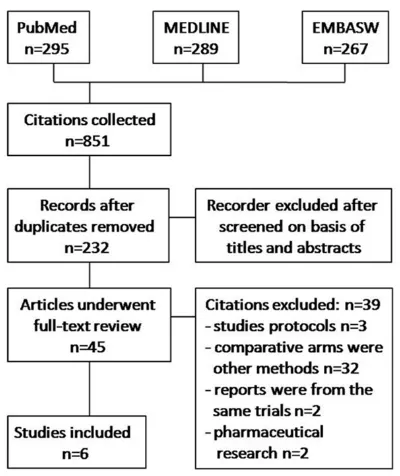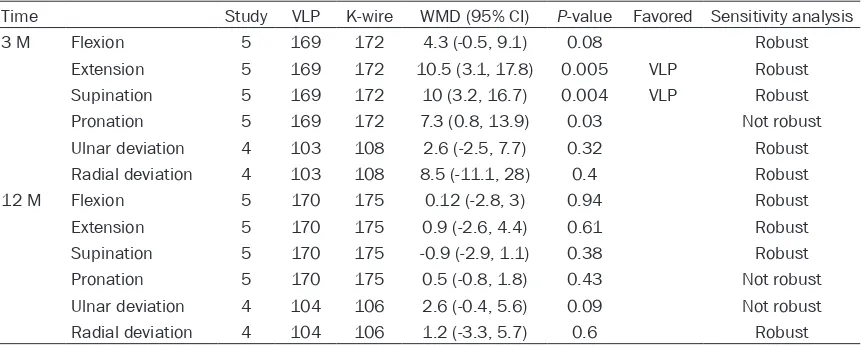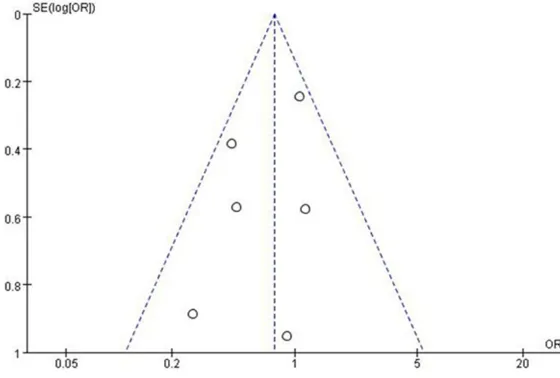Original Article
Volar locking plate fixation versus Kirschner wire
fixation in distal radius fractures: a meta-analysis
Jin Shao1*, De-Ce Kong2*, Tie-Yi Yang1
1Department of Orthopedics, Shanghai Pudong New Area Gongli Hospital, Second Military Medical University, 219 Miaopu Road, Pudong New Area, Shanghai, China; 2Graduate College of Ningxia Medical University, Yinchuan 750004, Ningxia, China. *Equal contributors.
Received January 21, 2016; Accepted May 12, 2016; Epub August 15, 2016; Published August 30, 2016
Abstract: Objective: The superiority of volar locking plate fixation and K-wire fixation on treatment of distal radius fractures was controversial. Thus, we performed a meta-analysis to compare the efficacy of volar locking plate and
K-wires for distal radius fracture. Methods: We searched Embase, Medline and PubMed for randomized controlled trials which compare the effects of volar locking plate and K-wire on treatment of distal radius fracture. Data analy-sis was performed by using the RevMan5. Results: Six studies met the inclusion criteria. The meta-analyanaly-sis results
showed volar locking plate fixation led to better DASH scores at 3 and 12 months, faster recovery of grip strength, extension and supination at 3 months. But there was no significant difference at 12 months in term of functions and motions recovery. Complications of the two methods were similar. Conclusion: The patients receiving fixation
with volar locking plate for the treatment of distal radius fracture achieved an early recovery of function compared to those with K-wire.
Keywords: Distal radius fractures, fracture fixation, internal, volar locking plate, kirschner wire, meta-analysis
Introduction
Distal radius fracture is one of the most com-mon orthopedic injuries, which occurs in a pro-portion of approximate 25% [1]. It affects all age groups and is more common in older patients especially those with osteoporosis [2]. Therapeutic alternatives for distal radius frac-ture included surgical and non-surgical treat-ment. Non-surgical treatment is used if the bone fragments can be held in anatomical alignment by a plaster cast or orthotic device. If
this is not possible, surgical fixation is per
-formed. External fixation (EF) with Kirschner
(K)-wire has historically been used for distal radius fractures [3-5]. More recently, internal
fixation (IF) with a volar locking plate is becom
-ing popularity and trends to replace K-wire fixa
-tion [6]. Favorers suggest that internal fixa-tion
with a volar locking plate results in a rapid fu-
nctional recovery. However, the others favor
K-wire because it is less expensive and has smaller surgical trauma with shorter operation
time. To data, the therapeutic option for distal radius fractures is still controversial.
Recently, some meta-analyses of randomized
controlled trials (RCTs) have compared EF with IF for treatment of distal radius fractures [7-9].
Those studies compared different types of
plate fixations with K-wire fixation or other EFs.
There was still lack of study directly comparing volar locking plate with K-wire. Thus, we per-formed this meta-analysis to evaluate clinical
outcomes comparing volar locking plate fixation with K-wire fixation.
Materials and methods
Search strategy and inclusion criteria
random-ized controlled trials on patients with distal radius fractures; (2) the studies compared volar locking plate with Kirschner wire; (3) the fellow up was above 12 months.
Data extraction and quality assessment
The following information from each study was
extracted independently by two reviewers: first
author name; year of publication; number of patients; the disabilities of arm, shoulder, and
hand (DHAS) score; patient rated wrist evalua -tion (PRWE) score; grip strength; range of motion; number of complications. The compli-cations during the 12 months follow up were analyzed. The Jadad score was used to assess the quality of the included studies [10]. The studies with score no less than 3 were regard-ed as high quality RCTs, while studies with
score less than 3 were defined as low quality
RCTs.
Data analysis
We measured the primary outcome DASH and
PRWE scores and the outcomes of grip streng- th, forearm range of motion and complication parameters. Data analysis was performed by
using the RevMan5. For each individual study,
dichotomous data were reported as odds ratio (OR) with 95% CI and continuous data were reported as weighted mean difference (WMD)
with 95% CI. Heterogeneity between studies was assessed by I-square test. A significant
level of no less than 50% for I-square test was
considered as evidence of heterogeneity. Fix
effect model was used when there was no evi-dence of heterogeneity, otherwise random effect model was chosen. To evaluate the sta-bility of the results of this meta-analysis, we performed a one-way sensitivity analysis, in
which we evaluated the influence of individual
studies by estimating the average relative risk in the absence of each study [11].
Results
Search results and characteristics
A total of 851 citations were obtained via data-base searches; six met the inclusion criteria for this study (Figure 1). A total of 820 patients with distal radius fractures were involved in this study, in which 409 patients were treated with volar locking plates, and 411 patients were treated with K-wires. The information in these citations is summarized in Table 1. Because of the obvious nature of intervention, it is impos-sible to perform double blind. All 6 studies have been assessed by Jadad score system with score no less than 3 (Table 1).
Comparison of the effects of volar locking plate and K-wire on PRWE and DHAS score
The results showed the volar locking plate had
better DASH scores at 3 and 12 months (Table 2; Supplementary Figure 1). The sensitivity analysis showed the results were robust (Table 2). We also compared the volar locking plate and K-wire on PRWE scores. At 12 months, the scores were not statistically different (Supplementary Figure 2; Table 2).
Comparison of the effects of volar locking plate and K-wire on grip strength and range of motion
Grip strength analysis at 3 months showed that
there was a significant difference favoring volar
locking plate over K-wire, but the difference neutralized over time; at 12 months the scores
were not statistically significant different (Table 3; Supplementary Figure 3).
The data of range of motion were extracted
from 3 to 5 studies. A significant difference in
[image:2.612.89.289.69.307.2]volar locking plate at 3 months postoperatively (Table 4; Supplementary Figure 4). However,
the range of motion of two therapies was simi-lar at 12 months.
Meta-analysis of complications
All the included studies had reports of total surgical complications. Meta-analysis results
showed that there was no significant difference
between volar locking plate and K-wire at 12
months (OR = 0.76, 95% CI 0.54 to 1.08; P =
0.12) (Figure 2).
Sensitivity analysis and publication bias
Sensitivity analysis showed the outcomes of PRWE score and pronation at 3 months and grip strength, pronation and ulnar deviation at 12 months were not robust, which suggested the result was not credible. The funnel plot based on studies with data on total
complica-Table 1. Main characteristics of the included studies
Study Age No. of patients(VLP/K-W) Fracture types Classification of fractures Follow up Jadad score
Egol et al. 2008 [12] 18-87 44/44 Unstable distal radial fractures AO type A, B, C 12 3 Rozental et al. 2009 [13] 19-79 23/21 Unstable distal radial fractures AO type A2, A3, C1, C3 12 3 Wei et al. 2009 [14] > 18 12/22 Unstable distal radial fractures AO type A3, C1, C2, C3 12 3 Wilcke et al. 2011 [15] 20-69 33/30 Dorsally displaced distal radius fracture AO type A, C 12 3 Karantana et al. 2013 [16] 18-73 66/64 Displaced distal radial fractures AO type A3, C2, C3 12 3
[image:3.612.90.528.86.178.2]Costa et al. 2014 [17] > 18 231/230 Dorsally displaced distal radius fracture AO type A, B, C 12 3
Table 2. Comparison of volar locking plate and K-wire regarding the PRWE and DHAS
Time Study VLP K-wire WMD (95% CI) P-value Favored Credibility
PRWE 3 M 2 242 239 -9 (-23.3, 5.4) 0.22 Not robust
12 M 2 228 231 -1.8 (-4.8, 1.2) 0.23 Robust
[image:3.612.90.526.212.284.2]DASH 3 M 5 169 172 -15.9 (-22.3, -9.5) < 0.0001 VLP Robust 12 M 6 368 376 -5.3 (-8.7, -1.9) 0.002 VLP Robust
Table 3. Comparison of volar locking plate and K-wire regarding the grip strength
Time Study VLP K-wire WMD (95% CI) P-value Favored Credibility Grip strength 3 M 4 148 151 15.4 (7.1, 23.6) 0.0003 VLP Robust
12 M 4 149 154 6.1 (-2.5, 14.7) 0.17 Not robust
Table 4. Comparison of volar locking plate and K-wire regarding the range of motion
Time Study VLP K-wire WMD (95% CI) P-value Favored Sensitivity analysis 3 M Flexion 5 169 172 4.3 (-0.5, 9.1) 0.08 Robust
Extension 5 169 172 10.5 (3.1, 17.8) 0.005 VLP Robust
Supination 5 169 172 10 (3.2, 16.7) 0.004 VLP Robust
Pronation 5 169 172 7.3 (0.8, 13.9) 0.03 Not robust
Ulnar deviation 4 103 108 2.6 (-2.5, 7.7) 0.32 Robust
Radial deviation 4 103 108 8.5 (-11.1, 28) 0.4 Robust
12 M Flexion 5 170 175 0.12 (-2.8, 3) 0.94 Robust
Extension 5 170 175 0.9 (-2.6, 4.4) 0.61 Robust
Supination 5 170 175 -0.9 (-2.9, 1.1) 0.38 Robust
Pronation 5 170 175 0.5 (-0.8, 1.8) 0.43 Not robust
Ulnar deviation 4 104 106 2.6 (-0.4, 5.6) 0.09 Not robust
[image:3.612.89.523.320.360.2] [image:3.612.92.524.397.570.2]tion was symmetrical, which indicated that there was no publication bias in our study (Figure 3).
Discussion
Our results indicated fixation with volar locking plate had a better DASH scores than K-wire fix -ation at either time point. The possible explana-tions are that volar locking plates have superior biomechanical properties with impact stiffness supporting the physiological loads placed on
the wrist joint [18]. However, there was no evi
-dence of a significant difference in PRWE score
between the treatment groups at 12 months.
Volar locking plate fixation led to an earlier
recovery of grip strength at 3 months after
operation. But there was no significant differ -ence between the two groups at 12 months. Our data also indicated that volar locking plate
ficiency of surgeons and different types of dis -tal radius fractures. Since the sample size of some RCTs was small, patient age was con- sidered as another source of heterogeneity. Previous study indicated that in patients
sixty-five years of age or older, surgery could not give
any improvement in terms of the range of
motion, PRWE and DASH scores [19]. We are
unable to perform a subgroup analysis for dif-ferent age to identify possible source of hetero-geneity, because none of the included study
reported outcomes of volar locking plate fixa
-tion and K-wire fixa-tion according to different
age group.
There are some limitations in our study. Firstly,
the study designs of the included trails were
slightly different. For example, Rozental et al.
study and Karantana et al. study reported out-come of range of motion at 3 months, while the
[image:4.612.95.519.74.203.2]others at 3 months. However, these trails were Figure 2. Comparison of the effects of volar locking plate and K-wire on complications.
Figure 3. Funnel plot to assess publication bias in the meta-analysis.
restored better extension and supination at 3 months, while these differences were not present at 12 months.
According to our meta-analy-sis results, volar locking plate
fixation and K-wire fixation
have a similar rate of total complications. The result was consistent with the previo- us meta-analysis (Xie et al. 2013) comparing internal and
external fixation of distal radi
-us fractures [7].
Significant heterogeneity was
[image:4.612.92.372.248.437.2]pro-analyzed together. The outcomes at 3 and 6 months were not analyzed in our meta-analy-sis, because the data were only given by a few studies. Secondly, the small sample size of the included trails may also increase the uncertain-ty of the results. Thirdly, we did not perform a pool analysis on activities of daily living and vocational function due to the limited number of trails.
In conclusion, the patient receiving fixation
with volar locking plate for treatment of distal radius fractures achieved an early recovery of
function compared to those with K-wire. How-ever, there was no significant difference at 12
months. The number of complications between the two treatments was similar. The volar
lock-ing plate fixation may be of advantage to some
patients requiring a faster recovery of function after surgery. In addition, large-size sample randomized controlled trials are needed to
identify our findings.
Acknowledgements
This work was supported by National Natural
Science Foundation of China (81201367), Key
Discipline Construction Project of Pudong
Health Bureau of Shanghai (PWZx2014-09), Shanghai Municipal Natural Science Founda-tion (10ZR1427700).
Disclosure of conflict of interest
None.
Address correspondence to: Dr. Tie-Yi Yang, Department of Orthopedics, Shanghai Pudong New
Area Gongli Hospital, Second Military Medical
University, 219 Miaopu Road, Pudong New Area,
Shanghai 200135, China. Tel: 86 21
58858730-5166; E-mail: yangtieyiyi@126.com
References
[1] Kotnis R, Waites MD, Fayomi O, Dega R. The
use of a template to improve the management of distal radial fractures. Emerg Med J 2005;
22: 544-547.
[2] Chen NC, Jupiter JB. Management of distal ra-dial fractures. J Bone Joint Surg Am 2007; 89:
2051-2062.
[3] Cooney WP 3rd, Linscheid RL, Dobyns JH. External pin fixation for unstable Colles’ frac -tures. J Bone Joint Surg Am 1979; 61:
840-845.
[4] Horne G. A prospective randomized trial of ex
-ternal fixation and plaster cast immobilization
in the treatment of distal radius fractures. J Orthop Trauma 1991; 5: 246.
[5] Kapoor H, Agarwal A, Dhaon BK. Displaced in -tra-articular fractures of distal radius: a com-parative evaluation of results following closed
reduction, external fixation and open reduction with internal fixation. Injury 2000; 31: 75-79.
[6] Downing ND, Karantana A. A revolution in the management of fractures of the distal radius?
J Bone Joint Surg Br 2008; 90: 1271-1275. [7] Xie X, Qin H, Shen L, Zhang C. Comparison of
internal and external fixation of distal radius
fractures. Acta Orthop 2013; 84: 286-291. [8] Wei DH, Poolman RW, Bhandari M, Wolfe VM,
Rosenwasser MP. External fixation versus in
-ternal fixation for unstable distal radius frac -tures: a systematic review and meta-analysis of comparative clinical trials. J Orthop Trauma 2012; 26: 386-394.
[9] Cui Z, Pan J, Yu B, Zhang K, Xiong X. Internal versus external fixation for unstable distal ra -dius fractures: an up-to-date meta-analysis. Int Orthop 2011; 35: 1333-1341.
[10] Jadad AR, Moore RA, Carroll D, Jenkinson C,
Reynolds DJ, Gavaghan DJ, McQuay HJ.
Asse-ssing the quality of reports of randomized clin-ical trials: is blinding necessary? Control Clin
Trials 1996; 17: 1-12.
[11] Tobias A. Assessing the influence of a single
study in the meta-analysis estimate. Stata Tech Bul 1999; 15.
[12] Egol K, Walsh M, Tejwani N, McLaurin T, Wynn
C, Paksima N. Bridging external fixation and supplementary Kirschner-wire fixation versus
volar locked plating for unstable fractures of the distal radius: a randomised, prospective trial. J Bone Joint Surg Br 2008; 90: 1214-1221.
[13] Rozental TD, Blazar PE, Franko OI, Chacko AT, Earp BE, Day CS. Functional outcomes for un -stable distal radial fractures treated with open
reduction and internal fixation or closed reduc
-tion and percutaneous fixa-tion. A prospective
randomized trial. J Bone Joint Surg Am 2009;
91: 1837-1846.
[14] Wei DH, Raizman NM, Bottino CJ, Jobin CM,
Strauch RJ, Rosenwasser MP. Unstable distal
radial fractures treated with external fixation, a
radial column plate, or a volar plate. A prospec-tive randomized trial. J Bone Joint Surg Am
2009; 91: 1568-1577.
[15] Wilcke MK, Abbaszadegan H, Adolphson PY.
Wrist function recovers more rapidly after volar
locked plating than after external fixation but
the outcomes are similar after 1 year. Acta
[16] Karantana A, Downing ND, Forward DP, Hatton
M, Taylor AM, Scammell BE, Moran CG, Davis TR. Surgical treatment of distal radial fractures with a volar locking plate versus conventional percutaneous methods: a randomized con-trolled trial. J Bone Joint Surg Am 2013; 95:
1737-1744.
[17] Costa ML, Achten J, Parsons NR, Rangan A,
Griffin D, Tubeuf S, Lamb SE; DRAFFT Study Group. Percutaneous fixation with Kirschner wires versus volar locking plate fixation in
adults with dorsally displaced fracture of distal radius: randomised controlled trial. BMJ 2014;
349: g4807.
[18] Levin SM, Nelson CO, Botts JD, Teplitz GA,
Kwon Y, Serra-Hsu F. Biomechanical evalua -tion of volar locking plates for distal radius fractures. Hand (N Y) 2008; 3: 55-60.
[19] Arora R, Lutz M, Deml C, Krappinger D, Haug L,
Gabl M. A prospective randomized trial com-paring nonoperative treatment with volar
lock-ing plate fixation for displaced and unstable distal radial fractures in patients sixty-five
Supplementary Figure 1. Comparison of volar locking plate and K-wire regarding the PRWE score.


